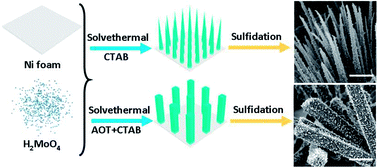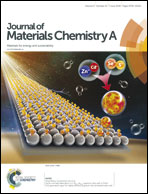Dimensional construction and morphological tuning of heterogeneous MoS2/NiS electrocatalysts for efficient overall water splitting†
Abstract
Water splitting for hydrogen production urges the development of cheap, efficient, and durable electrocatalysts. This paper describes the dimensional construction of nickel sulfide (NiS) and molybdenum disulfide (MoS2) with heterogeneous structures for the hydrogen evolution reaction (HER) and the oxygen evolution reaction (OER). The morphologies of MoS2/NiS can be finely tuned to aggregations, nanowires and nanocuboids by controlled addition of dioctyl sodium sulfosuccinate (AOT) and hexadecyl trimethyl ammonium bromide (CTAB) as surfactants. MoS2/NiS nanosheet coupled nanocuboids (MoS2/NiS NCs) exhibit the best and most stable electrocatalytic activity with 92 and 271 mV overpotentials at 10 and 15 mA cm−2 for the HER and the OER. MoS2/NiS NCs as an electrolyzer in alkaline media at a current density of 10 mA cm−2 can deliver a cell voltage of 1.61 V with remarkable 45 h durability, making them an ideal catalyst towards practical application for water splitting.



 Please wait while we load your content...
Please wait while we load your content...